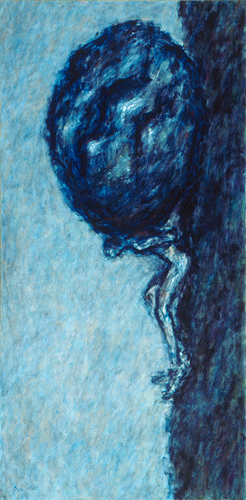I am very partial to Greek mythology so it was no surprise that I was attracted to the painting named Sisyphus, a king punished by being compelled to roll an immense boulder up a hill, only to watch it roll back down, and to repeat this action forever.

Sisyphus, c. 1660-1665, Antonio Zanchi (1631 - 1722)
 |
| Sisyphus, 2003 Matthew Felix Sun |
I found it worth pointing out that Zanchi painted no slope where the boulder was to repeatedly roll down. When I made a painting on the same subject three years before my trip to the Netherlands, I was more interested in the overall impression and narrative of the story, than depicting the character of Sisyphus. My boulder was much larger, the slope vertical and Sisyphus tiny without details. Very different take from Zanchi, whose version, if not for the title, it could be depicting any human being in such a struggle. That was why a well-known classic story so fascinating to reinterpret.
The other painting I liked very much from that Gallery was titled Argus, Mercurius and Io, by Jacob van Campen. Io was, in Greek mythology, a priestess of Hera in Argos, a nymph who was seduced by Zeus, who changed her into a heifer to escape detection. His wife Hera sent ever-watchful Argus Panoptes, with 100 eyes, to guard her, but Hermes was sent to distract the guardian and slay him. Heifer Io was loosed to roam the world, stung by a maddening gadfly sent by Hera, and wandered to Egypt, thus placing her descendant Belus in Egypt; his sons Cadmus and Danaus would then "return" to mainland Greece. [wikipedia.com]

Argus, Mercurius and Io, c.1630-1640, Jacob van Campen ( 1596 - 1657)
This painting was about disguise, deception and anticipation. Here, Van Campen used the Roman name of the god, Mercury, who was a smooth and graceful youth, confidently lured the old Argus to sleep. Argus was presented as a balding old man though with younger person's body, without his numerous extra eyes, which would adore Hera's peacock feathers. I almost felt pity for Argus, knowing that he would be slay by the deceptive Hermes. Also interesting to me were the two heifers in the background - one looked away indifferently, and the other peeping at the activity with intent interest - this one must be Io. I also like the parallel poses Hermes/Mercury and Argus - their torsos and limps, formed a diamond shape - diagonal, dynamic, yet serene and sleepy.
Few dogs scattered across the painting enriched the setting and added some intrigue and nervous energy. The gaze from Io/Heifer and from the black dog at the feet of Argus were full of anticipation and anxiety and I got a sense of upcoming storm, which was also reinforced by the dark clouds dramatically hanging high, again, in diagonal formation, added another touch of a high stake.
My Favorite Museum Collection Series
>> My Favorite Museum Collection Series 56: My Favorite Paintings in Groeninge Museum, Bruges (Brugge), Belgium
<< My Favorite Museum Collection Series 54: My Favorite Paintings in Mauritshuis, Den Haag, Netherlands





No comments:
Post a Comment